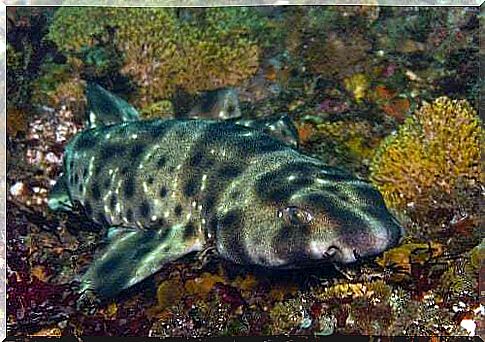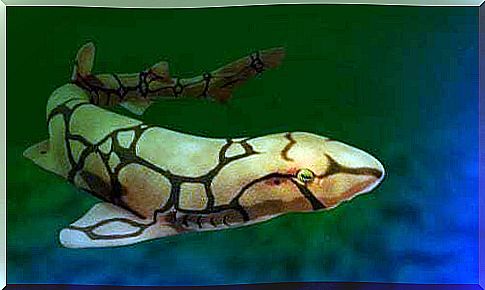The Secret Of The Sharks That Glow In The Dark

Bioluminescence is a phenomenon that characterizes some marine species and is used by many animals as a defensive strategy. In this article, let’s talk about the secret of sharks that glow in the dark.
Relatively recent discoveries reveal that, deep in the sea, there are sharks capable of emitting a bright green light through their skin. This quality doesn’t seem to be very useful when it comes to going unnoticed, however it offers many other benefits.
Sharks that glow with a green light
There are many animals that can emit light. Some do this thanks to the green fluorescent proteins called GFP, such as jellyfish and crustaceans, or indirectly through a symbiosis with the bacteria, responsible for this bioluminescence, as in the case of the squid Euprymna scolopes .
In 2019 a group of researchers discovered sharks that can communicate with each other thanks to the phenomenon of bioluminescence. We are talking about the cat shark Cephaloscyllium ventriosum and Scyliorhinus retifer , belonging to the same family, whose skin has a double tone: light and dark.
The reason they are able to emit light is the established metabolic pathway of bromine tryptophan kynurenine molecules, not previously described.

The cat shark Cephaloscyllium ventriosum, among the shining sharks
In addition to the light and dark tones, on the skin of this species there are fluorescent green spots arranged all over the body.
Shark Scyliorhinus retifer
Unlike the cat shark, this species is not characterized by fluorescent spots: the skin shows a pattern of chained black lines in which an alternation of dark and light areas is noted.
Advantages of bioluminescence
In the study published in the journal iScience, fluorescence microscopy was used to examine tissue samples from the skin of these sharks. The results showed that the fluorescence is distributed only in fair skin, differently between one species and another.
Another interesting discovery was that these sharks are specialized not only in emitting but also in detecting bioluminescence, thanks to a particular property of sight. This is an advantage, as they will not be visible in front of other fish, but will be able to communicate with each other.
On the other hand, the light they produce is emitted specifically within each species.
In this way, bioluminescence allows specimens of the same species to communicate with each other, as well as helping them to escape the eyes of other potential predators.
Metabolins: the shark “bulbs” that shine
The cat shark is benthic, so it moves sinuously on the seabed through the sediments of the depths. Marine bacteria such as Staphylococcus aureus and Vibrio parahaemolyticus reside on the seabed. This has led researchers to test bioluminescence-producing metabolites to see how they react against bacteria.
Scientists have found that these micro-molecules protect animals from attack by bacteria. This makes sense, given that these bioluminescent sharks are in constant contact with the sea floor.
Other properties of metabolites
In recent years, studies focusing on bioluminescence have made great strides in scientific advancement. But, despite the large number of publications explaining how and why this phenomenon occurs, we are really far from understanding how it works.
In addition to the data obtained in the research described above, another interesting discovery was observed. This is a parallel between the bromo-kynurenine biosynthetic pathway of metabolites and the tryptophan-kynurenine pathway that occurs in vertebrates.
The latter regulates various biological processes in humans. For example, the buildup of kynurenine in the brain which is related to mental disorders such as depression and schizophrenia. Therefore, these metabolites could play an important role in the central nervous system.

A world full of light
In light of these results, we can conclude by saying that the bioluminescence generated in these sharks has unique properties that are very different from those that occur in other living things.
These sharks possess metabolites that emit a bright green through the light areas of the skin. Thanks to this quality, these species are invisible to other marine creatures while they can easily recognize each other.
Likewise, it is these same molecules that protect them against bacterial infections. After all we have learned about these luminescent sharks, we just have to resign ourselves to the fact that nature will never cease to amaze us.









